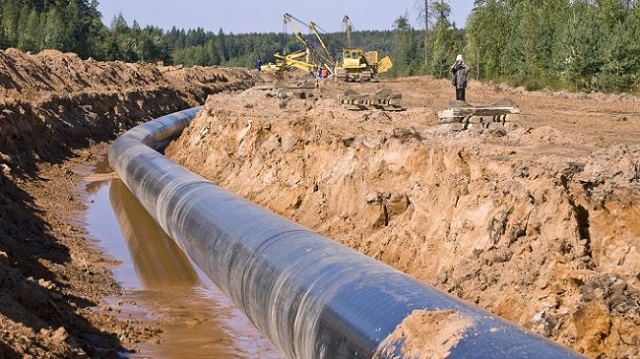
Kampala, Uganda | THE INDEPENDENT | Investors in the East African Crude Oil Pipeline will require five billion dollars to construct it. The cost of constructing the longest heated crude oil pipeline from Hoima to Tanga in Tanzania had been estimated to cost $3.5 billion.
At the time, the shareholders were required to raise $2.5 billion and $1 billion in equity to finance the project. The Minister of Energy and Minerals, Ruth Nankabirwa on Tuesday confirmed that the cost for the project has shot up to five billion dollars.
“After COVID-19, we realized that there was an increase in everything. And so the board sat and agreed that it is necessary to appreciate that everywhere in the world materials are expensive. And I think that is what caused the variance in cost,” Nankabirwa explained.
It means that the shareholders including the Uganda National Oil Company (UNOC) will have to ask for more money from the treasury to meet its obligations.
Some observers and analysts of the oil and gas sector had predicted that the cost was likely to rise due to factors like inflation and the rising material costs amidst the delay in the commencement of construction.
Penina Ahebwa, the Director for Economic and National Content Monitoring at the Petroleum Authority of Uganda (PAU) said while the shareholders should be worried about the rise in cost, the country at large shouldn’t be alarmed.
“In our negotiations, one of the things that we did, because we did not want to take on the inflation risk, we negotiated and fixed the transportation tariff. So that is a very good thing. But as shareholders, we are ensuring efficiency. So that the shareholders still get some good money,” Aheebwa explained.
The shareholders in EACOP are affiliates of the three Upstream joint venture partners (the Uganda National Oil Company, TotalEnergies E&P Uganda, and CNOOC Uganda) together with the Tanzania Petroleum Development Corporation. Shareholdings are TotalEnergies 62%, UNOC and TPDC 15% each and CNOOC 8%.
Peter Muliisa, the Chief Legal and Corporate Affairs at the Uganda National Oil Company explained that when the Final Investment decision for the Lake Albert project was taken, the shareholders did not include what he described as historical costs. This project involves the development of oil fields, processing facilities, and an electrically heated pipeline network.
“So the cots that had been incurred pre-FID were still being audited and understanding them. At the point after audit, the costs increased above $ 500 million. So that increases the CAPEX,” Said Muliisa. /
Muliisa explained that the pipeline had initially been designed to be powered by the burning of crude oil. “When we analyzed the impact emissions of that, we found that it wasn’t responsive as it was. We instead chose to put in place five solar farms. They will generate 80% of the power that the pipeline needs for oil to move” Mullisa explained.
He said the rest of the energy requirements for the pipeline will come from the grids in Uganda and Tanzania. “So in essence the pipeline is 100% powered by green energy. And that has added about $120 million to the Capital expenditure of the project”
He said the debt mobilization for EACOP has gone on well and that UNOC as an investor has continued to put in its equity because it is confident that debt mobilization will bear fruits.
“And I want to say that where we are now, we should be able to get the first drawn down on debt in April. The target we had given to the minister was June 2024. And I’m happy to say that we have done better. We wouldn’t close debt if we didn’t not have insurance companies of global stature supporting the project”
Uganda’s crude is medium-light 30° API, low in sulfur but very waxy, with a pour point of 40°C, making it solid at surface temperature. The EACOP website notes that “due to the viscous and waxy nature of Uganda’s crude oil, the pipeline will need to be heated along the entire route, making the EACOP the longest electrically heated pipeline in the world.”
The East African Crude Oil Pipeline project continues to be resisted by anti-fossil fuel campaigners who have cranked up protests wherever there are international meetings and conferences. Some of the protests led to the controversial resolution by the European Parliament in which it asked Uganda to halt the development of its oil and gas sector and the East African Crude Oil pipeline.
The Minister, Ruth Nankabirwa has insisted that the projects will go on as planned as Uganda prepares for first oil in 2025. The EACOP Company already received its construction license in January 2023 under the Petroleum (Refining, Conversation, Transmission and Midstream Storage) Act, 2013. The EACOP Company is expected to advertise several packages of work for the construction phases
. “Following the issuance of the License, EACOP Company has issued contracts for construction and line pipes. Early Civil Works are underway in Tanzania, with Nyanza Roads Ltd and JV Spec handing over Main Camps and Piping Yards to the China Petroleum Pipeline Engineering Company (CPP) for pipeline construction” Nankbirwa said.
TotalEnergies has indicated it will only approve new projects if they are low-cost and low emissions. And that the design of the facilities incorporates measures to limit greenhouse gas emissions well.
********
URN
 The Independent Uganda: You get the Truth we Pay the Price
The Independent Uganda: You get the Truth we Pay the Price



